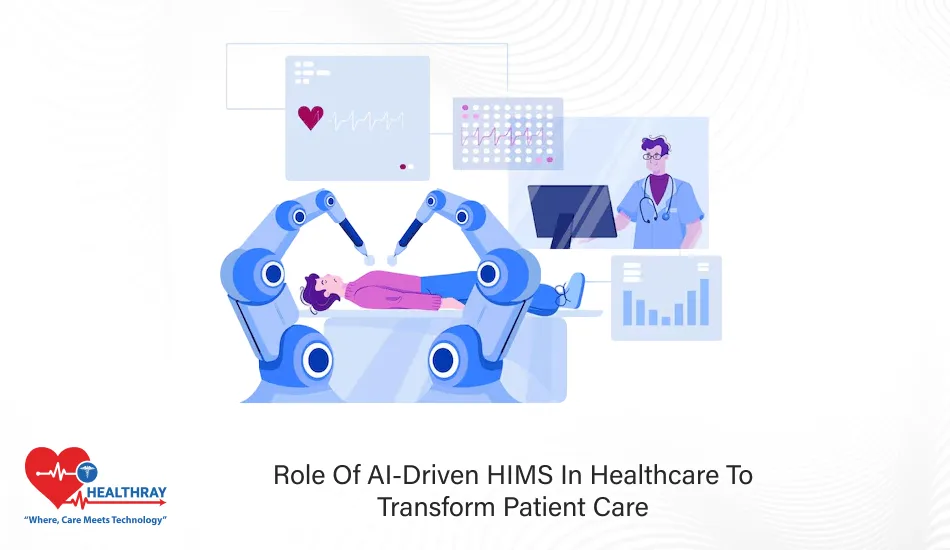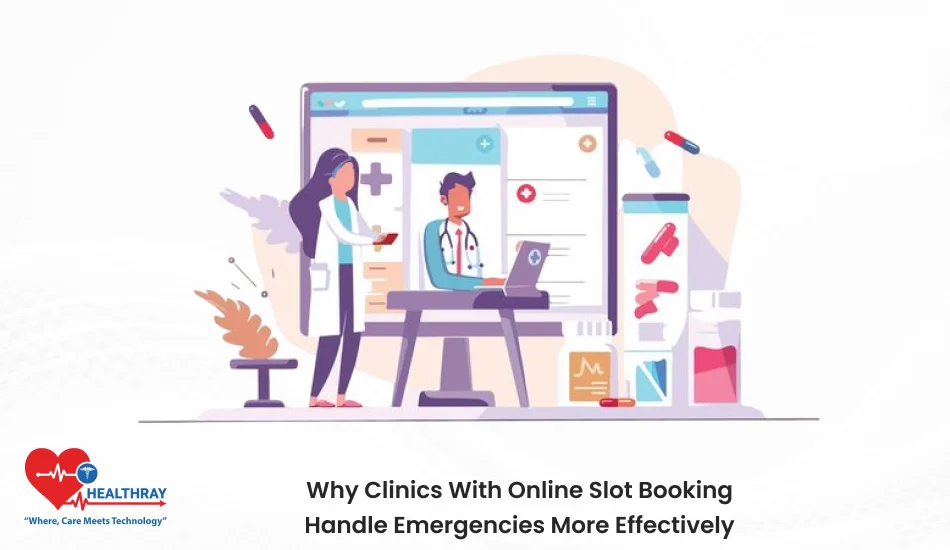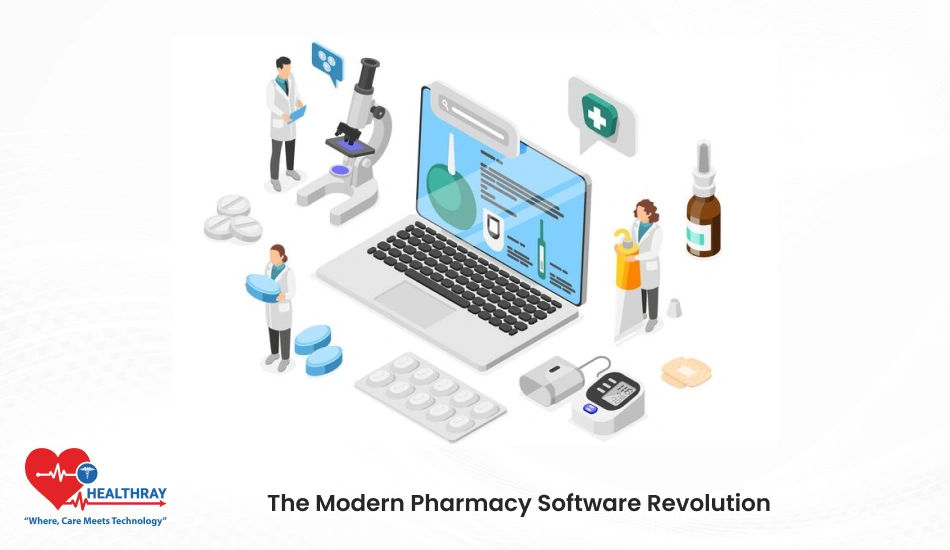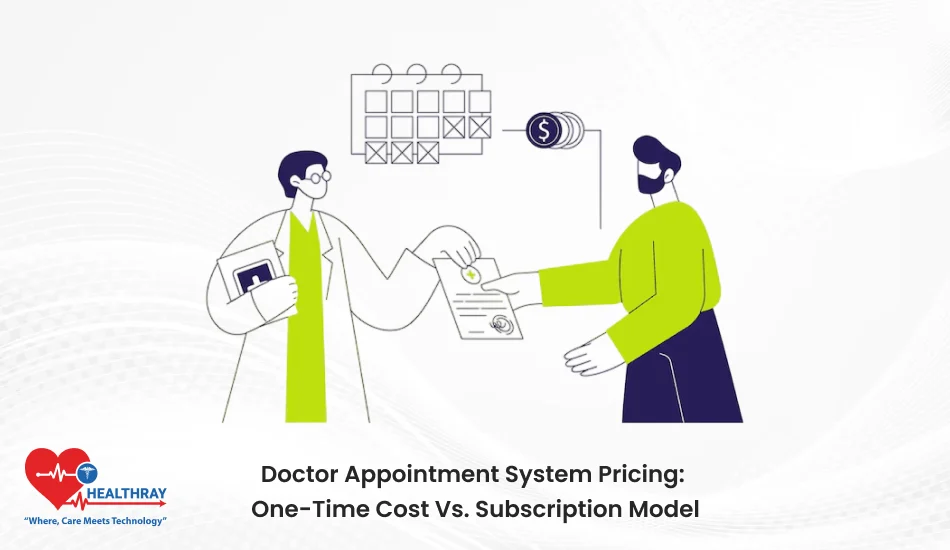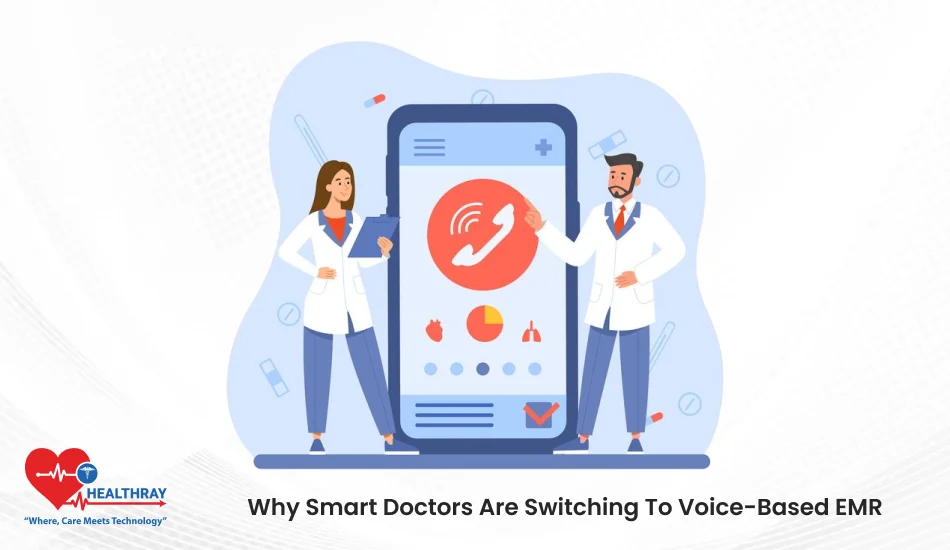AI-driven healthcare information management systems change the way patient care is delivered, managed, and enhanced. This system integrates data insight with deep algorithms to offer not just smoother administrative processes but a redefinition of how care is provided and treated for each particular patient.
In this article, we discuss the key role AI is starting to play within the framework of a Hospital Information Management System: advantages to both patients and providers of care and how it sets up a totally new paradigm in healthcare management. Whether you’re a healthcare professional on a mission to improve outcomes or a decision-maker planning technological advancements, this guide has all it takes to bring you up to speed.
Understanding AI-driven HIMS Hospital Software

Fundamentally, HIMS are online systems for managing information about the patients, facilitating administrative tasks, and enhancing operational efficiencies within health organizations. In their advanced forms, incorporating AI into the systems makes them powerful tools that can process a large quantity of data, establish patterns, and provide actionable insights.
Key Features of AI-driven HIMS:
- Data Processing Automation: AI increases speed and accuracy in handling patient records, appointments, and billing.
- Predictive analytics : Helps to identify potential health risks through the examination of patient histories and predictions of outcomes.
- Real-time Decision Support: AI-based recommendations are given to the clinician after processing patient data and established medical guidelines.
- Interdepartmental integration : Ensures smooth communication and coordination across different units, such as radiology, surgery, and pharmacy.
Why They Matter:
AI-powered HIMS take off the burden from routine or administrative chores, allowing practitioners to have more time for what is most important: attending to their patients. They also give considerable capacity to the hospitals and clinics in tackling some of the complex healthcare challenges that include big volumes of patients and diagnosis with accuracy.
Big Picture: AI-driven HIMS are not a matter of convenience but a serious leap toward efficient, accessible, personalized health care.
Benefits of AI-driven HIMS in Patient Care
AI-driven HIMS do not stop at administrative simplification but go further to restructure the way care is provided. Advanced algorithms and real-time data from such systems assist the practitioner in making better decisions, reducing errors, and providing personalized treatments.
Improved Diagnostics and Treatment
AI analogs scan and process data from the patients for the early detection of health problems. It finds patterns in symptoms, tests, and studies of images that might go unnoticed, hence allowing for quicker and more precise diagnoses. It also helps design personalized treatment plans that fit the patient’s particular needs.
Personalized Patient Care
AI systems now integrate all the various levels of a patient’s profile: medical history, genetics, and real-time health metrics. At that granularity, healthcare providers are afforded the ability to provide treatments and counsel specific to the needs of the patient, which results in better outcomes and satisfaction.
Predictive Analytics for Preventive Care
AI identifies high-risk patients much earlier, even before they develop grave conditions. Predictive analytics helps healthcare teams with earlier interventions that prevent complications and reduce hospital readmissions. An example could be an AI system flagging early signs of heart disease based on subtle changes in a patient’s health record.
Reduced Human Error
The mistakes may be at levels of diagnosis, medication, or treatment. AI-driven systems help mitigate human errors by putting a safety net around patients through checks and alerts. This ensures quality and patient safety.
Advantages of AI-driven HIMS Hospital Software on Operations
Inefficiency is often part of health operations, from wasting time on administrative activities to mismanaging resources. AI-driven HIMS step in by streamlining these operations and making healthcare facilities more efficient, thus better equipped to handle challenges.
Smooth administrative procedures
These administrative functions include scheduling, billing, and registration, which can be very resource-intensive and quite frequently prone to errors. AI automates these processes for accuracy, freeing the staff to spend more time on higher-value activities. For example, automated appointment scheduling systems reduce double-bookings and long wait times.
Improved Resource Allocation
AI-driven hospital information systems are based on the principle of predictive analytics that ensures the judicious distribution of resources. It can predict the number of patient arrivals during various peaks, and can thus fluctuate staffing, bed assignments, and supply chains accordingly.
This ensures that resources are utilized to the fullest at any given point in the hospital without overloading.
Error Reduction
Wrong medication, data entry, or even patient record entry might prove very detrimental. AI reduces the chances of these through real-time checks and warnings; it makes sure that the right information will reach the right person at the right time.
Cost Savings
It reduces operation-related costs by automating repetitive tasks and increasing efficiency. Administrative overheads, wasted resources in errors or delays, or other associated costs are saved in hospitals and clinics. These can be put to better use in patient care.
Improved interdepartmental coordination
Therefore, AI enables communication across boards of a hospital. Lab results for a patient can be shared in real time among his physician, pharmacist, and specialist to speed up his treatment process.
Implementation Strategies for AI-Driven HIMS
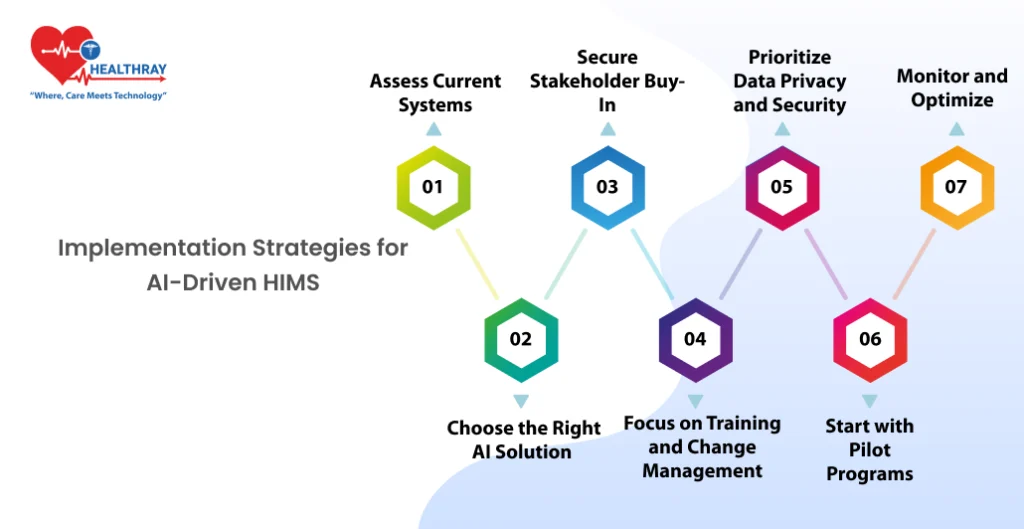
AI-driven implementation of HIMS requires a very clear strategic roadmap and collaborative involvement. This is not about mere technology adoption; it’s about process reshaping, staff training, and facing the challenges pertinent to implementation.
Current Systems Assessment
Begin with a proper analysis of the prevailing HIMS infrastructure. Gaps, inefficiencies, and areas where AI can most benefit need to be gauged. This would help identify how much integration is really needed.
Choose the Right AI Solution
Not all AI systems are equal, so find one that best suits your organizational goals: improving patient record management, enhancing diagnostics, and optimizing resource utilization. Find scalable systems that grow with your organization.
Gain Stakeholder Buy-In
Success in such implementation requires buy-in by stakeholders. Clearly communicate the added value of the AI-driven HIMS to the administrator, clinician, and IT communities regarding better patient outcomes, lightening the workload, and streamlining operations.
Focus on Training and Change Management
Adopting new technology requires equipping your team with the right skills. Practical training should be provided to staff on the use of the AI system with full confidence. Reduce resistance to change by showing employees the value and involving them in the process.
Ensure Data Privacy and Security
The AI systems process sensitive information about the patients, and security is thus non-negotiable. Employing effective encryption, abiding by the regulations on health, and performing periodic auditing are highly essential to avoid data breaches.
Start with pilot programs.
Also, make sure to run the program in one department or facility before a full-scale rollout. This will help you identify the various challenges, take feedback, and refine the implementation process. Scaling up will come later if that works.
Monitoring and Optimizing
AI-driven HIMS no doubt needs to be monitored constantly to make it function effectively. Utilize the insights from the data to understand which areas need improvement and introduce changes in the working system accordingly. Its regular updates and maintenance have kept it running efficiently.
Real-World Case Studies of AI-driven HIMS
Artificial Intelligence in health information management systems is no longer theoretical; various hospitals and clinics have already put such systems in place, yielding results that are nothing short of radical. Let’s look at a few such real-life examples and their impact.
Smoothening Patient Management in a Multispecialty Hospital
A large multispecialty hospital implemented AI-powered HIMS for patient recordkeeping and appointment management. Automating appointment scheduling decreased patients’ waiting time by 35%.
It also showed incompletely recorded patient data, ensuring the integrity of the data across all departments. It improved operational efficiency by 25% in the first year itself, thereby enabling the staff to spend more time with patients.
Predictive Analytics for Chronic Disease Management
In one medium-size clinic, an AI-powered HIMS was implemented for the management of chronic diseases. The system studied patients’ data and identified high-risk persons with recommendations on prevention. Because of this, emergency visits pertaining to chronic illnesses were reduced by 20%. According to physicians, patient outcomes improved because timely interventions were performed based on the advice of the system.
Improving Interdepartmental Collaboration
A regional hospital was experiencing communication issues related to patient treatment plans between the radiology, surgery, and pharmacy departments. After integrating an AI-driven HIMS, data acquired via diagnostic imaging would directly be accessible to surgeons and pharmacists without wasting any time. Seamless information-sharing processes like this cut down treatment delays by 40%, thereby improving the overall patient satisfaction scores.
Medication Error Reduction in a Teaching Hospital
A teaching hospital implemented an AI-enabled HIMS to overcome the issues of medication errors. The system flags probable drug interactions and warns staff about incorrect dosages. Over two years, the hospital reported a 60% reduction in medication-related incidents, thus ensuring safer care for the patients.
Lessons Learned from the Field:
- Pilot programs are usually crucial to understand and surmount the challenges.
- Smooth implementation is ensured through collaboration by IT teams and healthcare staff.
- Continuous training and feedback loops assure a maximum effect from the system.
Proof in action: The case studies presented herein demonstrate that AI-driven HIMS are no longer concepts but rather actual practices that have yielded concrete results in the way of bringing efficiency, minimizing errors, and improving patient outcomes. The latter now sets a new benchmark for healthcare management.
Challenges and Solutions: AI-driven HIMS Implementation
While AI-driven HIMS can bring immense benefits, this does not come without its own set of challenges. Grasping these hurdles and strategizing for solutions assures a smooth transition that maximizes the impact of such a system.
Data Privacy and Security Concerns
AI-driven HIMS deals with highly sensitive information about patients; therefore, many cyber attackers naturally target them. A breach will result in the loss of patient confidence and regulatory penalties.
Solution: Employ robust encryption protocols, perform periodic audits for security, and maintain health-related regulations, such as HIPAA or GDPR. Offer multi-layered security systems including firewalls, two-factor authentication, and access controls.
Resistance to Change
Health personnel are somewhat resistant to the implementation of new technologies due to fear that it may be too complex or that it might replace them, which could be an obstacle to being successful with AI integration.
Solution: Involve employees from the very beginning of the process. Provide them with extensive training, demonstrate the benefits of the system, and show them how it will make their work easier, not take their jobs.
High Initial Costs
The cost of acquisition and implementation of AI-driven HIMS can be an inhibiting factor, mainly for smaller healthcare organizations.
Solution: Begin with modular systems or phase the implementation to spread the expenses over time. Government grants, subsidies, or arrangements with providers that will offer the technology could help offset costs. Highlight long-term savings from improved efficiency.
Integration with Legacy Systems
Most health facilities still depend on obsolete systems, which might be incompatible with AI-driven HIMS. This would be a bottleneck in the implementation processes and therefore increase the time and costs.
Solution: Select the AI systems that are designed to be interoperable. In addition, engage vendors who can offer support to migrate legacy data and seamlessly integrate these into the new system.
Ethical and Legal Issues
AI also brings in issues of transparency and accountability in decision-making. For example, when an AI-powered recommendation yields a poor outcome, who is to blame?
Solution: Clearly outline guidelines with regard to the role of AI in making decisions. AI shall only be used to support and not replace clinical judgment. Stay updated on regulatory guidelines to maintain compliance.
Technical Expertise Gap
Not every health institution has the expertise to manage or maintain such advanced AI systems within their organizations.
Solution: Train the staff, either in-house or in collaboration with third-party providers; consider hiring health IT experts and universities offering such skill development programs.
Addressing Challenges Head-On: Every challenge comes with a solution. Appropriate planning, involvement of stakeholders, continuous improvement-these are how health care organizations can successfully integrate AI-driven HIMS and benefit from the transformative power in them.
Future Outlook: The Next Frontier for AI-driven HIMS

AI integration into HIMS is just the beginning of many far-reaching changes to healthcare. The more technology advances, the more sophisticated functionalities AI-driven systems are going to introduce, thus changing the way healthcare is provided and managed.
Emerging Trends in AI and HIMS
Predictive Analysis:
AI systems will identify risks but surge ahead into proactive disease prevention. Wearable devices, for example, would bring real-time health monitoring over HIMS and warn healthcare providers before symptom sets can escalate.
Natural Language Processing:
Improvements in NLP will, in the future, enable clinicians to control HIMS by voice. Such an interface would make some tasks, like keeping records, more intuitive and less time-consuming.
Personalized Medicine at Scale:
AI-driven HIMS will harness genomics and other personalized data to develop tailored treatment plans for a wider range of patients and will achieve better outcomes across diversified population groups.
Telemedicine:
AI-powered HIMS will form the backbone of telemedicine through analyzing the health data of a patient in virtual consultations, offering instant insights and thereby supporting diagnostics remotely.
Enhance Patient Engagement:
The future system will provide more opportunities for improved patient engagement whereby patients have better access to their personal health information. AI will support the patients further by suggesting recommendations to maintain chronic conditions or recover from surgery.
Possible Technological Advancements
AI robotics systems can perform surgery or other difficult diagnostic procedures more precisely and decrease the potential for human error.
Blockchain integration may add a whole new dimension to data security by making patient records tamper-proof and more transparent.
Augmented Reality-AR linked with HIMS can support both medical training and real-time support for procedures.
Preparing for the Future
Agility and adaptability are critical for healthcare organizations. Innovating from within, investment in emerging technologies, and collaboration with technology providers are three of the key elements that will help in staying ahead.
The future of AI-driven HIMS is bright, promising innovations that will make healthcare more precise, efficient, and patient-centered. Organizations that begin embracing these advancements today will go on to lead tomorrow.
Conclusion
AI-driven hospital management systems transform care delivery, management, and improvement. They enable healthcare organizations to streamline operations, enhance patient care, and transition toward proactive health management. Setting new standards of efficiency and precision in healthcare, they make possible everything from predictive analytics to personalized medicine.
Though there are challenges to surmount, including data security and resistance to change, these will not be impossible if proper strategies are involved. The providers need to begin embracing AI-driven HIMS today to ensure that they will remain competitive and well-equipped in the years to come.
